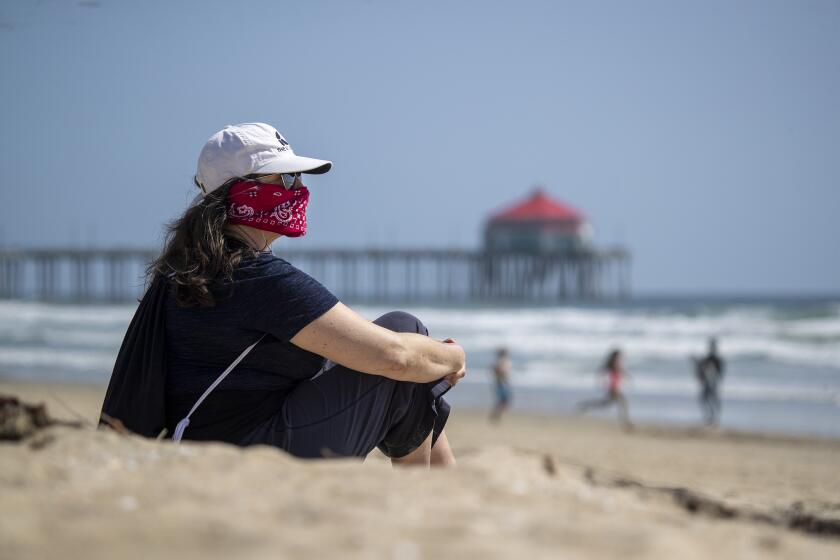Natural Perspectives: Getting to the bottom of drained wetland
A new freshwater wetland formed at Bolsa Chica, but someone drained it. That’s right, someone drained a wetland at the Bolsa Chica Ecological Reserve. Vic cautioned me to handle this issue with a cool and level head, but it chapped my hide to think that someone would deliberately drain a freshwater wetland in an area as fragile and contentious as Bolsa Chica.
But instead of going ballistic, I took action. I reported the draining to the California Coastal Commission and the Department of Fish and Game. Then I began investigating to find out who did it.
First, let me give you some background. This wetland is at the east end of the new footbridge by Warner Avenue. The area has always ponded a bit after storms. But ever since the installation of the footbridge, it has held a lot of water and has held it for quite some time. In January and February of 2010, the area was continually ponded.
This fits the definition of a vernal pool, which is a type of ephemeral, seasonal freshwater wetland. I thought this was a pretty exciting development, the formation of a potential vernal pool at Bolsa Chica. It was probably an accident of soil compaction by heavy equipment during bridge construction, but the area already had quite a bit of sloping, bowl-shaped topography. The soil compaction now allows water to collect there and stay for weeks.
After the heavy rains of December, the area again had a lot of water in it. I heard one report that the water was mid-calf-deep. The pond measured about 120 feet from east to west by at least 60 feet north to south, maybe more. I only measured it after most of the water was drained out, basing my measurements on water-logged, matted vegetation. The hand-dug, meandering channel that drained the wetland to the saltwater slough below the mesa was 40 feet long and about a foot deep. This was a deliberate act.
It didn’t take me long to learn that the channel was dug Jan. 2 during a Bolsa Chica Land Trust Steward work party. I sent an e-mail to Kim Kolpin, who leads the Stewards, but she didn’t respond.
I talked to Carla Navarro, the DFG biologist in charge of the area, and she said she had not given permission to anyone to dig a channel. She reported the incident to her supervisor, Karen Miner, and to U.S. Fish and Wildlife.
Navarro also talked to Flossie Horgan, executive director of the Bolsa Chica Land Trust, and Kolpin. They told Navarro that the Stewards had drained the wetland for “public safety” reasons. They claimed that they didn’t know it was a wetland. Navarro told them to fill the channel back in. As of this Monday, the drainage channel had still not been filled back in.
I talked to Andrew Willis of the California Coastal Commission, and he said that no one had filed for a permit to drain a wetland there, and that the Coastal Commission should have been notified first. Draining a wetland without a permit carries a hefty fine that can be levied for every day that the damage is not repaired.
Now here is where it gets interesting. The Coastal Commission wasn’t aware that a wetland existed in that spot. No one had reported it to them. Officially, it isn’t a wetland until the Coastal Commission biologists come out and assess it. So no fine can be levied. But they’re sure aware of it now and will be doing an assessment of the area.
There is yet another interesting twist to the story. Another pool, only about 10 feet by 6 feet, formed on the west side of the footbridge after the heavy December rains. When I was at Bolsa Chica on Jan. 13, Bolsa Chica Conservancy Executive Director Grace Adams excitedly announced that they had fairy shrimp in the pool. I looked, and sure enough, several fairy shrimp were swimming in the tiny pool.
Fairy shrimp are an indicator species for a vernal pool. Their eggs are carried on the feathers of birds that visit one pool after another. If the tiny pond on the west side had fairy shrimp, then the much larger pond on the east side probably did as well. Other ponded areas at Bolsa Chica and Shipley Nature Center have fairy shrimp, which could have provided an egg source. I looked for fairy shrimp in the mostly drained eastern pond, but the dead vegetation made it too difficult to see.
In talking to staff at the Coastal Commission, I learned that they were reviewing the mesa restoration plan that had been prepared by the Land Trust for DFG. Navarro confirmed that the plan is complete. I was surprised, because no one at the Conservancy nor the Amigos de Bolsa Chica had been informed. The Land Trust posted a notice in the public notices section of the Los Angeles Times on Jan. 16, which was all it was required by the California Environmental Quality Act to do.
Navarro informed me that public comments close Feb. 14, so half of the review time has already passed. The plan was also supposed to be posted online, but the person at DFG who was responsible for posting it was on vacation until this past Monday. Copies are available at the Huntington Beach Central Library, the DFG office at Shellmaker Island in Newport Beach and at the Bolsa Chica Land Trust office. We’ll give you our opinion of the plan in next week’s column.
VIC LEIPZIG and LOU MURRAY are Huntington Beach residents and environmentalists. They can be reached at LMurrayPhD@gmail.com.
All the latest on Orange County from Orange County.
Get our free TimesOC newsletter.
You may occasionally receive promotional content from the Daily Pilot.



